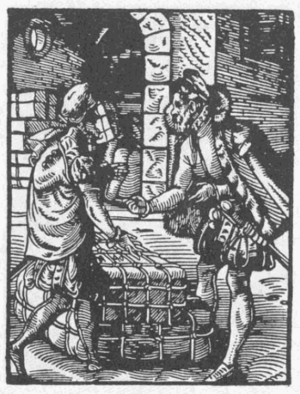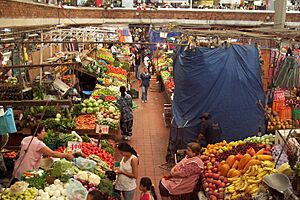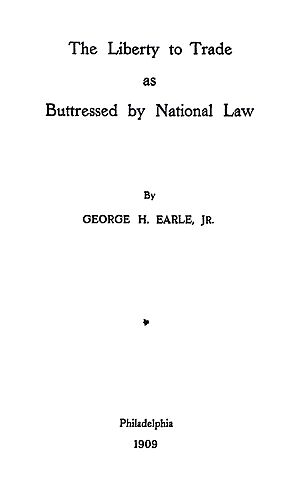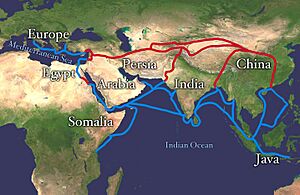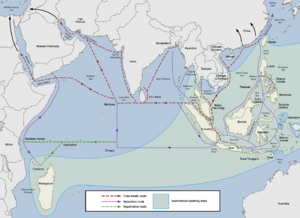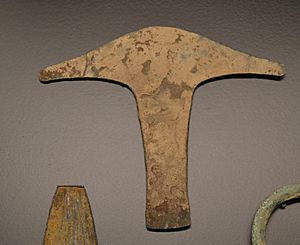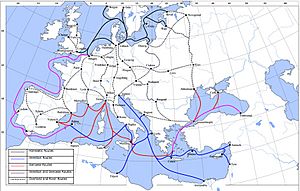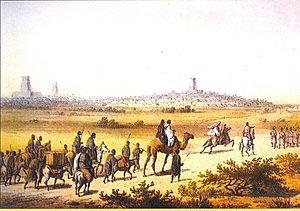Trade facts for kids
Trade is when people or groups exchange goods and services, often for money. Think of it like swapping something you have for something you need. When you buy a new video game, you are trading money for the game!
Economists call the system or place where trade happens a market. Traders usually use money or credit to make these exchanges. Long ago, people used barter, which means trading things directly without money, like swapping a basket of apples for a bag of grain. But money was invented even before writing, making trade much easier.
Today, things like paper money and digital money make trade simple. This is because buying and selling can happen at different times. When only two people or groups trade, it's called bilateral trade. If more than two are involved, it's multilateral trade.
Trade happens because people and places specialize. This means they focus on making one type of product or providing one service really well. For example, one country might be great at making cars, while another is good at growing coffee. They then trade their specialized products with each other. Different areas might also have a special advantage, like having unique natural resources. Trading helps everyone get what they need and want.
There are two main types of trade:
- Retail trade is when goods are sold directly to you, the customer. This happens in stores like a department store, online, or through mail. You buy things in small amounts for your own use.
- Wholesale trade is when goods are sold in large amounts to businesses. For example, a clothing factory sells many shirts to a retail store, which then sells them to customers.
Trade has grown a lot over time. It increased a lot from 1815 until World War I in 1914. It grew again in the 1920s but slowed down during the Great Depression in the 1930s. Since the 1950s, trade has increased a lot again. Experts believe that trade around the world is now at its highest levels ever!
Contents
The History of Trade
Trade has been happening since ancient times, long before written history. Early humans exchanged goods and services. Some experts believe long-distance trade started as far back as 150,000 years ago!
Early Trading: Prehistoric Times
In ancient times, people traded valuable materials like obsidian (a type of volcanic glass used for tools) and flint. Obsidian was traded over very long distances, sometimes up to 900 kilometers! It was highly valued because it made excellent cutting tools.
One of the earliest forms of writing, found in Syria around 10,000 BCE, was actually a system of clay tokens used for keeping track of trade. This shows how important trade was even then.
Trade in Ancient Civilizations
Long-distance trade routes began around 3,000 BCE. For example, people in Mesopotamia traded with the Harappan civilization in the Indus Valley. The Phoenicians were famous sea traders. They sailed across the Mediterranean Sea and even as far as Britain to find tin for making bronze. They set up trading posts called emporia.
In ancient Greece, Hermes was known as the god of trade. In ancient Rome, it was Mercurius. Trade was very important for the Roman Empire to grow and last. They had a safe transportation network that allowed goods to be shipped without much fear of piracy.
When the Roman Empire fell, trade in Western Europe slowed down. However, trade continued to thrive in Africa, the Middle East, India, China, and Southeast Asia.
Sea Trade in Asia
The first major sea trade network in the Indian Ocean was created by the Austronesian peoples from Southeast Asia. The Maritime Jade Road was a huge trading network that connected many parts of Southeast and East Asia. It mainly traded jade from Taiwan, which was shaped into tools and jewelry in the Philippines. This network lasted for at least 3,000 years, even before the famous Silk Road on land.
These skilled sailors also traded with Southern India and Sri Lanka as early as 1500 BC. They exchanged goods like coconuts, sandalwood, and bananas. Indonesian traders even reached East Africa, trading spices like cinnamon. This led to the settlement of Madagascar by Austronesian people.
Trade in the Americas
In ancient Mesoamerica (parts of Mexico and Central America), trade networks appeared around 1500 BCE. There is also proof of sea trade between Mesoamerica and cultures in South America and the Caribbean.
Trade in the Middle Ages
During the Middle Ages, trade grew in Europe through big trade fairs. People started to turn their wealth into capital (money or assets used to make more money). Banking systems also developed, allowing money to be transferred between countries. Local markets became a common sight in towns.
Central Asia was a major trading hub during this time. The Sogdians controlled the Silk Road from the 4th to the 8th centuries CE. They were the main merchants traveling by caravan across Central Asia.
Italian cities like Venice, Pisa, and Genoa were very important for trade in the Mediterranean and Black Sea. They controlled trade between Europe and the Near East for centuries.
The Vikings and Varangians also traded as they sailed from Scandinavia. The Hanseatic League was a group of trading cities that controlled trade in Northern Europe and the Baltic Sea from the 13th to the 17th centuries.
The Age of Exploration and Industry
In 1498, Portuguese explorer Vasco da Gama found a sea route to India by sailing around Africa. This opened up the European spice trade, which was very important economically. Spices from the East were incredibly valuable, sometimes as precious as gold!
From the 16th century, European merchants traded with West African states. They bought gold, spices, cloth, timber, and unfortunately, slaves as part of the triangular trade. They often exchanged these for cloth, iron, or cowrie shells.
In the 16th and 17th centuries, the Seventeen Provinces (parts of modern-day Netherlands and Belgium) were a center of free trade. They allowed goods to move freely without many controls. The Dutch East India Company, once the world's largest company, went bankrupt in 1799 partly because of the rise of competitive free trade.
In 1776, Adam Smith wrote an important book called An Inquiry into the Nature and Causes of the Wealth of Nations. He argued that countries could benefit greatly from specializing in what they do best and then trading with others. He believed that controls on imports and exports actually hurt a country.
In the 19th century, economists like David Ricardo developed the idea of comparative advantage. This means that even if one country is better at making everything, both countries can still benefit by trading what they are *relatively* best at producing.
Trade in the 20th and 21st Centuries
The Great Depression in the 1930s caused a huge drop in trade worldwide. Many believed that a lack of free trade made the depression worse. After World War II, countries wanted to prevent future depressions. In 1944, 44 countries signed the Bretton Woods Agreement. This agreement set up rules and organizations like the International Monetary Fund and the World Bank to help manage the global economy. In 1947, many countries also agreed to the General Agreement on Tariffs and Trade (GATT) to encourage free trade.
The European Union has become the world's largest exporter of goods and services. It is also a huge market for about 80 countries.
Today, trade is part of a complex system where companies try to make the most profit by offering products and services at the lowest cost. International trade has helped the world economy grow a lot, thanks to things like Industrialization, better transportation, and globalization.
Different Ideas About Trade
Free Trade
Free trade is a policy where a government does not put special taxes (called tariffs) or limits on imports or exports. It means goods can move freely between countries. This doesn't mean there are no rules, but it aims to make trade as open as possible.
Free trade has grown a lot in recent decades:
- In 1992, the European Union removed barriers to trade between its member countries.
- In 1994, the North American Free Trade Agreement (NAFTA) began, allowing free trade between the United States, Canada, and Mexico.
- In 1995, the World Trade Organization (WTO) was created. Its goal is to help free trade by ensuring fair trading rules for all member countries.
Protectionism
Protectionism is the opposite of free trade. It's a policy where a government tries to limit trade with other countries. This is often done by adding tariffs (taxes on imports) or setting quotas (limits on how much can be imported). Protectionist policies were very common in the 1930s during the Great Depression.
Fair Trade
The "fair trade" movement wants to make sure that goods are produced using good labor, environmental, and social standards. This is especially true for products from developing countries sold in richer countries. Fair trade aims to ensure workers are paid fairly and that products are made in a way that protects the environment.
Money and Trade
The first forms of money were objects that had value on their own. This is called commodity money. Examples include pigs, rare seashells, or even cattle. In ancient Iraq, bread was sometimes used as money. In the Aztec Empire, cocoa beans were used as currency!
Later, currency was introduced as standardized money to make trading easier. Early coins were often just lumps of valuable metal. Over time, coins became more organized and were used widely to represent value and make trade simpler.
Trade Around the World
International Trade
International trade is simply the exchange of goods and services between different countries. It's a huge part of most countries' economies. While international trade has always existed (think of the Silk Road), it has become much more important in recent centuries because of Industrialization, better transportation, and globalization.
Countries that have embraced international trade, like South Korea, have often seen their economies grow much faster than countries that kept their trade more closed, like India in the past.
Trade Sanctions
Sometimes, countries put trade sanctions on another country. This means they limit or stop trade with that country to punish it for certain actions. An embargo is a very strong sanction where one country completely blocks all trade with another. For example, the United States has had an embargo against Cuba for over 60 years.
|
See also
 In Spanish: Comercio para niños
In Spanish: Comercio para niños


